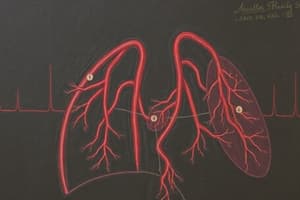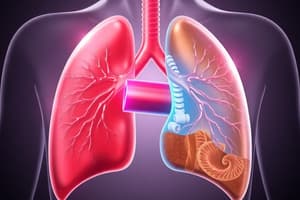Podcast
Questions and Answers
What is a potential consequence of chronic pulmonary hypertension?
What is a potential consequence of chronic pulmonary hypertension?
- Decreased pulmonary blood flow
- Reduced vascular resistance
- Right ventricular heart failure (correct)
- Increased oxygen uptake
In the upright position, what causes greater hydrostatic pressure in the lung's lower vessels?
In the upright position, what causes greater hydrostatic pressure in the lung's lower vessels?
- Gravity (correct)
- Decreased cardiac output
- Increased blood viscosity
- Constricted blood vessels
What happens to capillary transit time during exercise?
What happens to capillary transit time during exercise?
- It remains constant at 1 second
- It increases to 2 seconds
- It becomes unpredictable
- It decreases to approximately 0.3 seconds (correct)
What is the primary factor that prevents pulmonary oedema under normal conditions?
What is the primary factor that prevents pulmonary oedema under normal conditions?
What can cause pulmonary oedema if left atrial pressure rises significantly?
What can cause pulmonary oedema if left atrial pressure rises significantly?
How much of the total body mass does the brain roughly account for compared to its percentage of cardiac output?
How much of the total body mass does the brain roughly account for compared to its percentage of cardiac output?
What is the main role of diuretics in the treatment of pulmonary oedema?
What is the main role of diuretics in the treatment of pulmonary oedema?
What could lead to increased capillary pressure and subsequent fluid filtration?
What could lead to increased capillary pressure and subsequent fluid filtration?
How much does the oxygen consumption of grey matter account for total body consumption at rest?
How much does the oxygen consumption of grey matter account for total body consumption at rest?
What is the normal range for pulmonary capillary pressure?
What is the normal range for pulmonary capillary pressure?
What is the primary purpose of pulmonary circulation?
What is the primary purpose of pulmonary circulation?
What characteristic of pulmonary circulation contributes to its low resistance?
What characteristic of pulmonary circulation contributes to its low resistance?
What is the mean arterial pressure in the pulmonary circulation?
What is the mean arterial pressure in the pulmonary circulation?
Which mechanism primarily regulates pulmonary vascular tone?
Which mechanism primarily regulates pulmonary vascular tone?
What is the impact of chronic hypoxic vasoconstriction on the heart?
What is the impact of chronic hypoxic vasoconstriction on the heart?
Which feature of alveoli facilitates efficient gas exchange?
Which feature of alveoli facilitates efficient gas exchange?
How does the bronchial circulation primarily serve the lungs?
How does the bronchial circulation primarily serve the lungs?
What is the primary function of a high density of capillaries in the alveolar wall?
What is the primary function of a high density of capillaries in the alveolar wall?
What is the effect of pulmonary artery pressure during normal functioning of the lungs?
What is the effect of pulmonary artery pressure during normal functioning of the lungs?
What is the primary role of the ventilation-perfusion ratio?
What is the primary role of the ventilation-perfusion ratio?
What is the primary role of high capillary density in active muscle?
What is the primary role of high capillary density in active muscle?
What occurs in the capillaries at rest regarding perfusion?
What occurs in the capillaries at rest regarding perfusion?
Which agent is NOT thought to act as a vasodilator?
Which agent is NOT thought to act as a vasodilator?
How does adrenaline affect blood vessels in skeletal muscle?
How does adrenaline affect blood vessels in skeletal muscle?
What is the main purpose of cutaneous circulation?
What is the main purpose of cutaneous circulation?
What is the primary function of arteriovenous anastomoses (AVAs) in apical skin?
What is the primary function of arteriovenous anastomoses (AVAs) in apical skin?
Under what control are arteriovenous anastomoses primarily regulated?
Under what control are arteriovenous anastomoses primarily regulated?
What happens to AVAs when the core temperature increases?
What happens to AVAs when the core temperature increases?
What adaptation is typical of circulatory structures associated with specialized functions?
What adaptation is typical of circulatory structures associated with specialized functions?
What effect does a decrease in core temperature have on sympathetic tone in AVAs?
What effect does a decrease in core temperature have on sympathetic tone in AVAs?
Flashcards are hidden until you start studying
Study Notes
Blood Supply to the Lungs
- The lungs have two circulations: bronchial and pulmonary
- Bronchial circulation meets the lungs' metabolic requirements, part of the systemic circulation
- Pulmonary circulation supplies blood to alveoli for gas exchange
Pulmonary Circulation Characteristics
- Accepts the entire cardiac output
- Works with low pressure and low resistance
- Mean arterial pressure 12-15mmHg
- Mean capillary pressure 9-12mmHg
- Mean venous pressure 5mmHg
Adaptations for Efficient Gas Exchange
- High capillary density in alveolar wall for large surface area
- Short diffusion distance, thin layer between gas and plasma
- High oxygen and carbon dioxide transport capacity
The Blood-Gas Barrier
- Thin layer between alveolar air and capillary blood compromising of type I pneumocyte and endothelial cell
Ventilation-Perfusion Ratio
- Matching alveolar ventilation with perfusion for efficient oxygenation
Hypoxic Pulmonary Vasoconstriction
- Ensures optimal ventilation perfusion ratio
- Hypoxia in alveoli causes vasoconstriction of pulmonary vessels
- Optimizes gas exchange by redirecting blood flow away from poorly ventilated alveoli
Chronic Hypoxic Vasoconstriction
- Can lead to right ventricular failure
- Occurs at altitude or with lung diseases like emphysema
- Increases vascular resistance, leading to chronic pulmonary hypertension
- High afterload on right ventricle can lead to right ventricular heart failure
Pulmonary Vessels and Gravity
- Low pressure pulmonary vessels are strongly influenced by gravity
- In an upright position, hydrostatic pressure is higher in lower lung vessels:
- Vessels in the apex collapse during diastole
- Vessels at the base are continuously patent, distended by gravity
Effects of Exercise on Pulmonary Blood Flow
- Increased cardiac output
- Opens apical capillaries
- Increased oxygen uptake by lungs
- Reduced capillary transit time as blood flow increases
- At rest 1s
- During exercise 0.3s
Lung Lymph Formation
- Low capillary pressure minimizes lung lymph formation
Pulmonary Edema
- Increased capillary pressure causes fluid leakage, leading to edema
- Impairs gas exchange
- Treated with diuretics and addressing the underlying cause
Cerebral Circulation
- Brain has a high oxygen demand, receiving 15% of cardiac output
- Grey matter oxygen consumption accounts for 20% of total body consumption at rest
- High capillary density and reduced diffusion distance support high oxygen demand
Cerebral Circulation Adaptations
- Increased flow due to metabolic hyperaemia
- Vasodilators:
- Increased potassium concentration
- Increased osmolarity
- Inorganic phosphates
- Adenosine
- Increased hydrogen ion concentration
Cutaneous Circulation
- Plays a role in temperature regulation
- Skin is the main heat dissipating surface
Acral Skin and Arteriovenous Anastomoses
- Specialized structures called artereovenous anastomoses (AVAs)
- Specialized structures play a role in heat loss
AVAs and Temperature Regulation
- Under neural control, sympathetic vasoconstrictor fibers
- Reduced vasomotor drive allows AVAs to dilate, creating a low resistance shunt to venous plexus
- Allows skin temperature to rise, dissipating heat
Summary
- Each circulation has a specialized function
- Adaptations exist to meet the specific needs of each circulation
- Clinical problems can arise in various circulations
Studying That Suits You
Use AI to generate personalized quizzes and flashcards to suit your learning preferences.




